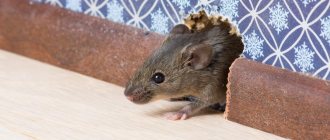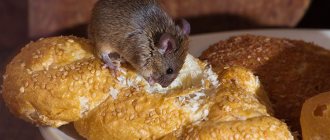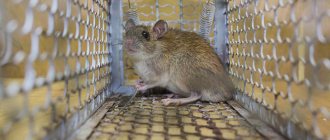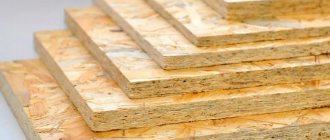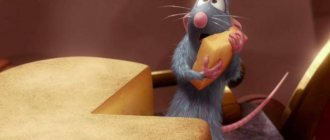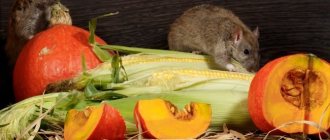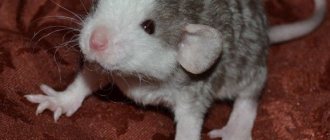Structure and appearance
The vole mouse is small in size. Its body length is 10-13 cm without a tail, and its weight is no more than 15 g. It has an elongated pointed muzzle, wing-shaped plates on high cheekbones, small ears and black or brown beady eyes. The compact paws with small feet have short claws. Due to the fact that the field mouse is constantly digging for something, they are never sharp.
The rodent's body is covered with fairly stiff hair, which becomes coarser with age so that it can be compared to the spines of a hedgehog. The upper part of the vole's body is brownish-ochre in color, and the abdomen is covered with pale gray fur. There is a longitudinal dark stripe on the back of the rodent.
The color of the animal changes depending on the climate and latitude of its habitat. The red mouse is mainly found in southern Europe. And voles in western Siberia, Altai, Semirechye and the Urals often have a chestnut-brown coat.
On a note. Young field mice have a more saturated color. Older individuals have paler fur, sometimes with graying.
Field mouse: description
Description of the field mouse:
- Body length no more than 12 cm, excluding tail. The thin tail makes up 70% of the body length.
- The body is oblong. The hind feet are elongated and protrude forward when running.
- Long muzzle, small round ears, oblong nose.
The fur is hard, rough, short. The colors can be different - gray, brown, ocher or beige. A straight line of black or brown shade runs along the spine. The color of the abdomen is snow-white. At the base the hairline has a dark tint. Small spots may be present on the chest.
This is interesting! The shade of the animal's fur depends on its age. The older the field mouse, the lighter its fur. With age, the dark base of the hairline begins to lighten. Individual hairs may be gray.
The vole mouse has unique teeth ; a pair of long incisors on the lower jaw grow throughout its life. To prevent their excessive growth, and they grow at a rate of 1-2 mm per day, the mouse is forced to continuously grind them off against hard objects.
As for weight, the average animal does not weigh more than 20 grams.
Varieties
Vole mice are distinguished depending on their habitat:
- common - found on the Eurasian continent;
- red - lives in the sultry Asian steppes;
- forest - lives in the forest-steppe regions of Eurasia and North America;
- underground - settles in local areas and in communications.
Interesting! In addition to the above species, there is a water vole. But it belongs not to mice, but to rats and inhabits the coasts of slow-flowing rivers and lakes with abundant vegetation.
Duration and lifestyle
Voles living in natural conditions live no longer than 2 years. If they are placed in a comfortable environment and provided with proper home care, their life expectancy can increase 5 times.
Voles are nocturnal mice. During the day, rodents sit in their nests, and at nightfall they go out hunting. Field mice live in shelters made from piles of branches and straw or in shallow burrows.
Animal burrows consist of numerous underground passages, the length of which is several tens of meters. There are also storage rooms, sleeping nests and backup passages, one of which necessarily leads to a pond.
On a note. The activity of field mice does not depend on the time of year. With the onset of frost, rodents do not hibernate and move under a layer of snow. Therefore, voles are forced to constantly obtain food and stock up.
Habitat
Thanks to its high adaptability, the field mouse easily adapts to different conditions and is found almost everywhere. The habitat of a rodent with a black stripe on its back covers many regions:
- coast of the Azov and Black Seas;
- Ciscaucasia;
- Northeast China;
- South of Siberia;
- northern Finland;
- western Denmark;
- west of the Baltic coast.
On a note. Field mice are not found in Crimea, Mongolia and Transbaikalia. These rodents do not live in high mountains and desert areas.
Voles inhabit forests, fields, meadows, hills and swampy areas. Rodents are found in basements, farmland, barns and residential areas.
Interesting Facts
Voles are interesting animals with many interesting things associated with them:
- Despite their small size, these animals are considered malicious pests. Rodents destroy grains, watermelons, sunflowers, tomatoes, carrots and potatoes.
- Voles can move at speeds of up to 10 km per hour.
- The vole mouse carries dangerous diseases, including hemorrhagic nephrosonephritis, erysipelas, tick-borne typhus fever, leptospirosis and tularemia.
- Field mice live in families that consist of 3-4 generations.
- Males are characterized by pronounced territorial behavior. Each of them occupies an area of up to 1.5 km and jealously guards its possessions from foreign encroachments. Field mice often start fights for territory, which end in the death of the weaker opponent.
- These rodents have a daily routine that includes sleeping, eating, caring for their fur coat and burrow.
Nutritional Features
The field mouse is a herbivorous rodent with constantly growing incisors that need to be ground down. To control the length of its teeth, the animal is forced to constantly chew something and in a day is able to eat no less than its own weight.
The diet of field mice includes:
- seeds and herbs;
- cereals;
- nuts and cone seeds;
- berries;
- young bark of berry bushes and broad-leaved trees;
- aboveground and underground parts of plants.
Also, field mice sometimes feast on earthworms, larvae and insects. Rodents will not refuse cereals, legumes, sausages, lard, flour and bakery products.
On a note. From mid-summer, field mice begin to collect food supplies. For the winter, rodents accumulate up to 3 kg of food and manage to eat it before the weather warms up.
Natural enemies of mice and voles
In nature, mice have a huge number of enemies that regulate their population. Mice are the favorite food of birds of prey. Owls, owls, eagles, hawks and other predators actively hunt mice. For example, in a year an adult owl can eat more than 1000 animals.
For many mammals (badger, wolf, fox, marten, weasel, ferret), mice are the main, often exclusive food. An adult ferret catches and eats up to 12 mice per day. The weasel is extremely dangerous for rodents, as it has a narrow body that can bend and penetrate mouse holes, destroying small cubs.
They enjoy eating voles and reptiles (snakes and large lizards), hedgehogs, and, of course, the most famous mouse hunter, the cat.
Reproduction and offspring
Field mice reach sexual maturity at 3-3.5 months and are capable of producing 3-4 litters per year, each of which produces 5-7 babies. Their pregnancy lasts on average 22 days and ends with the appearance of blind and completely helpless cubs.
The pups develop very quickly and after about 3 weeks they are completely ready for independent living.
Interesting! Experts were able to record cases of pregnancy in 13-day-old field mice, which after 20 days gave birth to viable pups.
How to draw a needle mouse with a pencil and pen step by step
Using a hard pencil, draw the outline of the mouse.
Step 2
Use a black ballpoint pen to darken the eyes, leaving room for highlights. We outline the ears and lower part of the mouse along the contour.
Step 3
Use a soft pencil to darken the pupils, as shown in the figure. After this, shade the mouse and shade it with a piece of paper. Next, we darken the ears and draw the fur on the forehead with short strokes in the direction from the nose to the top of the head.
Step 4We detail the fur, while darkening the pattern along the contour
Pay attention to the direction of the strokes. Draw a mustache with a well-sharpened pencil
Step 5
Using a black pen, draw a shadow under the mouse. Then shade the area around the black shadow with a soft pencil and blend it with a piece of paper.
Population and species status
The species of voles is very diverse and includes about 60 subspecies, which can only be identified through genetic research. Moreover, the mice themselves accurately identify representatives of other populations and do not interbreed with them.
The number of voles varies by year and season. Every 3-5 years, experts record an increase in the birth rate. Under optimal conditions, up to 2000 mice live per 1 hectare. In unfavorable times, the number of voles is reduced to 100 individuals per 1 hectare. Despite such fluctuations in the number of mice, there is no talk about the threat of their extinction. But among them there are rare species that are protected.
These include the following varieties of voles:
- Central Kashmir;
- Taiwanese;
- Japanese red;
- Mexican;
- Balukhistan;
- Muyskaya;
- Evronskaya.
Vole mouse and man
People have long considered this small, nimble animal to be their enemy. Choosing a place to live close to human dwellings, storage facilities and arable land, voles cause damage to stocks and plantings, and they are also carriers of many infectious diseases.
Thunderstorm of gardens, fields and vegetable gardens
In the years when reproduction is most active, the damage that the vole causes to plants is greatly noticeable:
- gnaws underground parts, causing the death of the plant on the root;
- spoils root crops and melons;
- sharpens grain and seed reserves;
- gnaws the bark of young bushes and trees.
Voles eat farm produce not only on the ground, but also in storage facilities, elevators, stacks and stacks, and cellars.
Important! It is not difficult to understand that a family of voles has settled on your site: the colony will be identified by the so-called “runways” - traces left on the surface from digging underground burrow paths.
Dangerous carrier
The vole mouse can be a carrier of extremely serious diseases, many of the pathogens of which can cause death in humans. Cute and funny animals, especially in large numbers, can cause:
- typhus;
- leptospirosis;
- tularemia;
- erysipelas infections;
- toxoplasmosis;
- salmonellosis, etc.
They became notorious due to the fact that they are practically the only natural carrier of plague in the Transcaucasian region.
Why you can’t completely destroy voles
Like any species on our planet, voles occupy their place in an ecological niche. By eating grass seeds, they limit the growth of the grass cover, which prevents young trees from breaking through to the light, thereby preserving the forests. In addition, their role in the food chain is very important for the population of birds of prey and many fur-bearing animals. In those years when few mice are born, the number of foxes, owls and other animals that feed on voles decreases. Some species of voles are rare and endangered and are protected:
- Evronian;
- Muyskaya;
- Balukhistan;
- Mexican;
- Japanese red;
- Taiwanese;
- Central Kashmir.
Prevention measures
To reduce the likelihood of voles settling on your property, you can:
- get a cat or dog;
- do not drive away the natural enemies of mice, especially owls;
- do not allow the area to be cluttered with equipment, firewood, faulty furniture, etc.;
- constantly loosen the ground, destroying the “grooves” of field mice;
- promptly dispose of trimmed branches, leaves, weeds and other garden debris.
To combat voles, it is necessary to use an integrated approach that combines prevention, creating an environment that is uncomfortable for rodents, and physical destruction.
Sources
- https://faunistics.com/mysh-polevka/
- https://GdeKlop.ru/myshi/polevaya/
- https://VrediteliSOS.ru/gryizunyi/mishi/mysh-polevka.html
- https://prusakam.net/polevaya-mysh/
- https://wildfauna.ru/mysh-polevka
- https://zverek.org/myshka-polyovka.html
- https://simple-fauna.ru/wild-animals/mysh-polevka/

